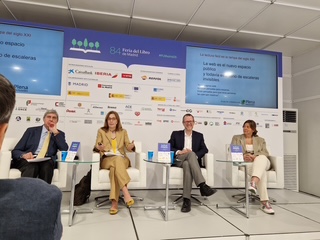
On June 11th, researcher Lourdes Moreno participated alongside María Xesús Bello Rivas and Óscar García Muñoz in an event moderated by Professor José Luis García Delgado, Director of the Nebrija Observatory of Spanish. The event was held at the Ibero-American Pavilion of the Ministry of Foreign Affairs, European Union and Cooperation, as part of the Madrid Book Fair.
The main focus of the event was the pre-launch of the White Paper on Easy-to-Read Language and the Comprehensible Web, an initiative led by the Nebrija Observatory of Spanish. This resource will soon be available and is set to become a valuable tool at various organizational levels and for diverse audiences.
Above all, it was an event for sharing and listening. Many of you joined us, thank you for your enthusiastic and engaged participation. The discussion addressed what easy-to-read language is and emphasized how many people benefit from easy-to-read content and cognitive accessibility. A broad overview of the regulatory framework on cognitive accessibility was also presented.
What is cognitive accessibility on the web?
Lourdes Moreno focused her talk on cognitive accessibility on the web. There is still little awareness of what it means, yet we constantly experience its barriers:
-
“There’s so much on the webpage that I can’t find what I’m looking for.”
-
“I filled out the form and clicked a button… but I don’t know if it was submitted or if something’s missing.”
-
“I was on a webpage and, without doing anything, another one opened. I got disoriented.”
-
“Suddenly, the design changed, and I didn’t know if I was still on the same website.”
-
“The webpage I have to read has a lot of text and difficult words. I don’t really understand what it says.”
If a website is designed following cognitive accessibility guidelines—which affect both content and interface—some key recommendations are:
-
Clear visual hierarchy and structured headings
-
Avoid unexpected changes
-
Short, guided navigation paths
-
Progress indicators
-
Ability to go back without losing data
-
Visual support for orientation
-
Avoid automatic movement
-
Step-by-step explanations
-
Avoid long, unstructured blocks of text
-
Allow personalization
-
Use visual aids
-
Avoid relying on memory
-
Use clear examples and cases
And let’s not forget the importance of complementing content with easy-to-read versions. Many people want—and have the right—to be informed, to read books, access services… and they need easy-to-read language.
This brings us to a key question: How can we effectively integrate easy-to-read content into websites? We are on that path. It’s essential to avoid fragmentation in how easy-to-read texts are published. There are design patterns that support cognitive accessibility, and we need to work together to reach consensus on these mechanisms so that people can easily identify and access such content.
It is essential to note that legislation mandates websites to comply with the WCAG (AA) and UNE-EN 301 549 standards. With the European Accessibility Act, there is increasing focus on these standards. Meeting them is essential to ensure access, but they do not automatically include cognitive accessibility—we must actively optimize for it.
Designers and developers are already familiar with usability and user experience principles. Now it’s time to go a bit further and achieve truly cognitively accessible websites.
Research from the HULAT Group – HumanAI Project
At the HULAT research group (UC3M), we work precisely in this area: creating systematic processes to support the generation of easy-to-read content following standards and regulations, and designing cognitively accessible interfaces. Together with the NIL group (UCM), we are deeply involved in the HumanAI project, where we will be publishing various resources for everyone.
We use generative artificial intelligence, but with an essential requirement: involving people in the process, especially individuals with cognitive limitations, reading comprehension difficulties, and other groups at risk of exclusion from the much-hyped world of generative AI.
🌐 https://humanai.uc3m.es
👉 With #HumanInTheLoop, we enhance #CognitiveAccessibility in #AI
#EasyToRead #CognitiveAccessibility #WhitePaper #MadridBookFair #HumanAI #WebAccessibility #InclusiveDesign
